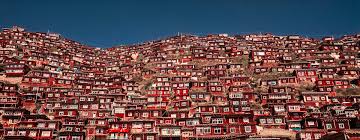Larung Gar in Garzê Tibetan Autonomous Prefecture, Sichuan province, is home to a Tibetan Buddhist academy that is believed to be the largest in the world, once home to thousands of monks and nuns. Last June, authorities ordered the population of the Larung Gar Buddhist Academy to be substantially reduced to 3,500 nuns and 1,500 monks, after which the destruction of monastic dwellings at the institute began and many monastic residents were to leave. While rights groups loudly called for an end to the destruction at Larung Gar, state media presented the destructions as part of a “renovation” project.
Earlier this month, state media again refuted claims of evictions while reporting on further “renovations,” claiming they were being done in the name of public health and increased safety. Human Rights Watch this week reported on continuing demolitions and evacuations at Larung Gar and nearby Yachen Gar, providing evidence of the harrassment of former monastic residents after they were forcibly sent back to the Tibet Autonomous Region, and again calling for the the demolitions to end:
Chinese authorities should halt the expulsion and political re-education of monks and nuns from a major Tibetan religious institution, Human Rights Watch said today. According to a statement by an abbot of the institution, Chinese officials announced on March 12, 2017, that 3,225 homes at Larung Gar, the world’s largest Tibetan Buddhist institution, would be torn down by April 30.
Many of the monks and nuns already expelled from Larung Gar and the nearby religious community at Yachen Gar, both in Tibetan areas of Sichuan province, have been forced to return to the Tibet Autonomous Region (TAR) and subjected to exceptional restrictions on their liberty and to degrading treatment. In November 2016, the authorities forced at least one group to undergo political re-education and apparent public humiliation in Nyingtri (Linzhi in Chinese), in southeastern TAR.
“China is aggressively dismantling religious freedom along with religious life at Larung Gar by subjecting many expelled monks and nuns to forced re-education,” said Sophie Richardson, China director at Human Rights Watch. “The restrictions imposed on former residents should be removed so they can exercise fully their rights to religious practice, including freely joining religious institutions and observing religious rituals.”
A senior abbot said in a speech to the community on March 23 that the monks and nuns “who have left had never wanted to leave… And whether or not they had some place to go, they still had to leave.” He added that “the demolitions and expulsions come from the policy of the senior levels of government, and cannot be discussed” and called on all monks and nuns to “show great forbearance and not react with protest, suicide and the like.” […] [Source]
Human Rights Watch also posted video footage of young women believed to be former nuns from Larung Gar chanting an official propaganda song declaring the genetic and cultural homogeneity between Tibetans and Han Chinese, and described another video showing 12 nuns dancing on a stage for an audience of officials to another Mao-era propaganda song celebrating the “liberation” of Tibet.
The abbot’s comment dissuading protest and suicide comes amid a wave of Tibetan self-immolations in protest of Beijing’s policies in Tibetan regions of China, with 147 cases since 2009. At Radio Free Asia, Lhuboom reports further on the senior abbot’s call for calm, noting that the call came ahead of a provincial official’s inspection of the site this week:
“Tomorrow [March 30, 2017], the head of Sichuan province is coming to review the demolition work begun on March 24 by Chinese government workers and laborers,” the abbot said in a March 29 talk to his followers, a recording of which was obtained by RFA’s Tibetan Service.
“Since most of the members of our community are young, you should all concentrate on your religious practice and studies and remain peaceful,” the abbot said.
Following the expulsion in 2016 and early this year of over 5,000 Larung Gar monks and nuns and demolition of their homes, about 2,000 dwellings are left to be destroyed, with work scheduled for completion by April 30, sources said in earlier reports.
“These have been tough and hard years four our monks and nuns, both mentally and physically,” the abbot said in his remarks. “We have only a month left to go now, so all must be very careful and remain patient and tolerant.” [Source]
Last month, the New York Times reported on a UN statement condemning the official actions at Larung Gar and Yachen Gar as “severe restrictions of religious freedom,” and asking Beijing to provide justification for the purported renovation project and descriptions of resettlement efforts. The recent Human Rights Watch report notes that the UN claimed that China did respond, and also called for that response to be published.
In recent months, Beijing has made a series of moves to situate its controversial pick of the Panchen Lama, the second highest-ranking cleric in the Gelug school of Tibetan Buddhism, in a higher profile. Beijing’s Panchen Lama has also made recent public comments promoting patriotism and love of the Party to Tibetan monastics. Some believe the increased official attention and state media promotion of the controversial cleric may be an indication that China will attempt to have their Panchen Lama fill the traditional political role of the Dalai Lama after the exiled and aging spiritual leader’s death.








